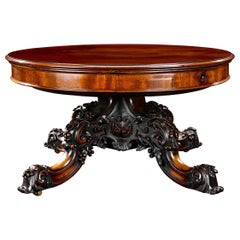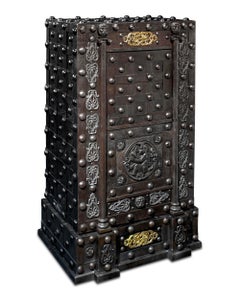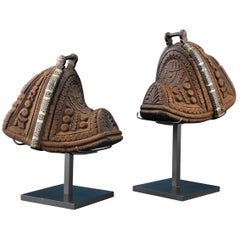Want more images or videos?
Request additional images or videos from the seller
1 of 6
19th Century Egyptian Revival Obelisk Models
$7,850List Price
About the Item
- Dimensions:Height: 20.75 in (52.71 cm)Width: 5 in (12.7 cm)Depth: 5 in (12.7 cm)
- Style:Egyptian Revival (In the Style Of)
- Materials and Techniques:
- Place of Origin:
- Period:
- Date of Manufacture:19th Century
- Condition:
- Seller Location:New Orleans, LA
- Reference Number:Seller: 30-42561stDibs: LU891119959952
About the Seller
5.0
Recognized Seller
These prestigious sellers are industry leaders and represent the highest echelon for item quality and design.
Established in 1912
1stDibs seller since 2010
112 sales on 1stDibs
Typical response time: 8 hours
Authenticity Guarantee
In the unlikely event there’s an issue with an item’s authenticity, contact us within 1 year for a full refund. DetailsMoney-Back Guarantee
If your item is not as described, is damaged in transit, or does not arrive, contact us within 7 days for a full refund. Details24-Hour Cancellation
You have a 24-hour grace period in which to reconsider your purchase, with no questions asked.Vetted Professional Sellers
Our world-class sellers must adhere to strict standards for service and quality, maintaining the integrity of our listings.Price-Match Guarantee
If you find that a seller listed the same item for a lower price elsewhere, we’ll match it.Trusted Global Delivery
Our best-in-class carrier network provides specialized shipping options worldwide, including custom delivery.You May Also Like
Pair of Grand Tour Egyptian Porphyry Obelisks, 19th Century
Located in Spencertown, NY
The pair of obelisks with gilt lion faces on front base and gilt lion paws at corners, signed indistinctly. Rome dated 1893.
Category
Antique 1890s Italian Grand Tour Architectural Models
Materials
Porphyry, Bronze
Pair of Obelisks, Red Serpentine, Cornwall England 19th Century
Located in Greding, DE
Pair of small obelisks out of red serpentine with hieroglyph decor (North side Cleopatra's Needle, today Central Park, NY - and Lateranobelisk situated o...
Category
Antique 19th Century English Egyptian Revival Abstract Sculptures
Materials
Serpentine
$3,644 Sale Price / set
20% Off
H 11.42 in W 3.55 in D 3.55 in
Egyptian Revival Black Rouge Griotte Marble Obelisk Grand Tour Pair 19th Century
Located in Cheltenham, GB
Egyptian Revival Black Rouge Griotte Marble Obelisk Grand Tour Pair 19th Century
A pair of black marble obelisks decorated with bas-relief hieroglyphs continued to the plinth bases ...
Category
Antique Late 19th Century French Egyptian Revival Obelisks
Materials
Belgian Black Marble, Griotte Marble
$3,295 / set
H 16.15 in W 5.52 in D 3.94 in
Late 19th Century Gothic Revival Reliquary Casket
Located in Dusseldorf, DE
A Gothic Revival reliquary. Circa late 19th / early 20th century. Made of solid oak with fine carving.
Reliquaries have been used to store relics since the Middle Ages. In sacred architecture they are often located behind the main altar in the chancel. In addition to classical, often church-like caskets, anthropomorphic, so-called "speaking" reliquaries were also made, which already inform the viewer about their contents through their own design. Mostly they were made of precious metals and decorated with rich sculptural ornaments or precious stones. One of the most famous examples of reliquaries is the Epiphany shrine of Nicholas of Verdun from the late 12th or early 13th century in Cologne Cathedral.
The reliquary offered here has an architectural structure with a rectangular ground plan. The three-sided glazed box with a dormer roof rests on a plinth.
A total of 8 columns of Corinthian order form the arcades which are crowned on both long sides by 3 lancets each and enclose the lancet windows...
Category
Antique Late 19th Century German Gothic Revival Religious Items
Materials
Glass, Oak
19th Century German Antique Mahogany, Walnut Model of an Egyptian Temple
Located in West Palm Beach, FL
A light-brown, antique German model of an Egyptian temple made of handcrafted, partly painted Mahogany and Walnut, in good condition. The inside of the de...
Category
Antique Early 19th Century German Architectural Models
Materials
Mahogany, Walnut
$9,500
H 12 in W 17 in D 24.5 in
French Egyptian Revival Carved Wood Figure of King Tutankamun
Located in Stamford, CT
A carved standing figure of King Tutankamun wearing the royal headdress topped by the double uraeus. This compelling carving depicts the slender boy king standing with arms crossed h...
Category
Early 20th Century French Egyptian Revival Figurative Sculptures
Materials
Wood
Antique French Bronze & Polished Marble Egyptian Revival Pocket Watch Stand
Located in Hamilton, Ontario
This antique pocket watch stand is unsigned, but presumed to have originated from France and date to approximately 1920 and done in the period Egypt...
Category
Early 20th Century French Egyptian Revival Collectible Jewelry
Materials
Marble, Bronze
$1,499
H 9.75 in W 4.75 in D 4 in
Neo-Gothic 19th Century Octagonal Pedestal / Stand / Architectural Model
Located in Troy, NY
An unusual pedestal of octagonal Neo-Gothic form, the molded base supporting eight shaped and carved columns decorated with typical Gothic designs, topped by eight spikes surrounding...
Category
Antique Mid-19th Century English Gothic Revival Pedestals
Materials
Oak
$5,850
H 57 in W 17 in D 17 in
Impressive Early 19th Century Model Chateau
Located in Pease pottage, West Sussex
Extraordinary Early 19th Century Chateau Model found untouched in its original painted finish. impressive attention to detail with some carved brickwork,...
Category
Antique Early 19th Century French Architectural Models
Materials
Wood
Robert Brendel's Botanical Model, 19th Century
By Robert Brendel
Located in New York, NY
A Botanical model by Robert Brendel, famous German botanist, 19th century.
As detailed by the University of Aberdeen Zoology Museum, "In the late 19th century Botanist and model-mak...
Category
Antique 1890s German Other Models and Miniatures
Materials
Wood, Lacquer
More From This Seller
View All19th Century Exhibition Model of Expanding Table by Samuel Hawkins
By Samuel Hawkins
Located in New Orleans, LA
A masterpiece of both cabinetmaking and mechanical engineering, this one-of-a-kind expanding table was crafted by the renowned cabinetmaker Samuel Hawkins of London for the Great Exhibition of 1851. Diminutive in size, the fascinating table was designed as a model to demonstrate Hawkins’ innovative patent screw movement to visitors of the Exhibition – six million people in total over five months. It was exhibited again a century later at the Victoria & Albert Museum during the Festival of Britain, an event intended “to symbolise two main qualities of the national character: realism and strength on the one hand, and, on the other, independence and imagination” (Catalogue of the Exhibition, 1951, p.117). To this day, the miniature masterpiece demonstrates the quest of English furniture makers to combine technical innovation with superb craftsmanship.
Displaying exceptional ingenuity, Hawkins’ wind-out screw mechanism allowed one to extend the table’s base to accommodate concentric leaves with the simple crank of a handle. It is based on the inventive expanding table originally designed by Robert Jupe in 1835, which used a swivel mechanism to separate sections of the tabletop and allow for segmented leaves to be inserted. Hawkins’ tabletop, on the other hand, extends outwards directly from the center in order to accommodate additional leaves around its diameter. This unique design allowed the mechanism to also smoothly operate on rectangular tables, which could be wound out from the middle to allow for more table space.
Hawkins was not alone in his endeavor to combine the technical merits of engineering and mechanics with the most artful pursuit of cabinetmaking. The first half of the 19th century saw a prolific increase in the popularity of applying new ideas to traditional furniture principles, which allowed furniture to serve many purposes. The resulting “patent” furniture was practical and refined, though few were as innovative as Hawkins’ prodigious design.
Carved with the year of the Exhibition on the beautifully designed pedestal base, the table is a testament to the significance of this innovation. The model is mentioned in detail in the catalog of the Great Exhibition of 1851, the first international exhibition of industry, manufacturing, and science. Held at London’s dazzling Crystal Palace, its visitors were treated to exhibits from around the globe, including feats of engineering, innovations in industry, and marvels of design. Queen Victoria herself was a frequent visitor, along with her husband, Prince Albert, and others including Charlotte...
Category
Antique 19th Century English Other Tables
Materials
Mahogany
19th-Century French Floor Safe
Located in New Orleans, LA
French Floor Safe
Magaud de Charf
Circa 1830
A marvel of mechanical ingenuity and exceptional craftsmanship, this fully functioning French hobnail safe represents one of the most se...
Category
Antique 19th Century French Historical Memorabilia
Materials
Iron
$124,500
19th Century Chilean Huaso Spurs
Located in New Orleans, LA
This rare and authentic pair of Chilean spurs is stunning to behold. Traditionally worn by huasos, or Chilean cowboys, these silvered steel spurs, or esp...
Category
Antique 19th Century Chilean Other Arms, Armor and Weapons
Materials
Steel
19th Century Chilean Huaso Stirrups
Located in New Orleans, LA
This striking and rare pair of Chilean wooden stirrups are true gems. Also known as estribos, these stirrups are carved from a solid block of wood. Tak...
Category
Antique 19th Century Chilean Other Arms, Armor and Weapons
Materials
Silver, Steel
19th Century Swiss Gold Musical Vinaigrette
Located in New Orleans, LA
This early 19th century Swiss gold vinaigrette has the charming addition of a musical mechanism. The entire box is crafted of 14-karat yellow gold envelo...
Category
Antique 19th Century Swiss Neoclassical Decorative Boxes
Materials
Gold, Enamel
19th Century Watch Winding Display Cabinet
Located in New Orleans, LA
This incredible, one-of-a-kind watch display cabinet brings together the beauty of an antique with the functionality of modern technology. Crafted of mahogany, this 19th century jewelry display cabinet...
Category
Antique 19th Century Unknown Empire Cabinets
Materials
Mahogany
Recently Viewed
View AllMore Ways To Browse
Napoleon Egypt
Theodore Antiques
Vintage German Glass Ornaments
German Christmas Tree
Ancient Coins
War Shell
World War Ii Furniture
Alexander Hamilton
Antique Feather Tree
Charlie Brown Vintage
Wooden Sleds
German Santa Claus
Mid Century Christmas Ornament
Antique Artillery Shells
German Christmas Santa
Royal Flag
Buzz Aldrin
Dwight Eisenhower



